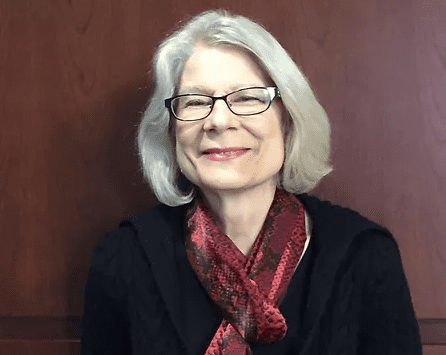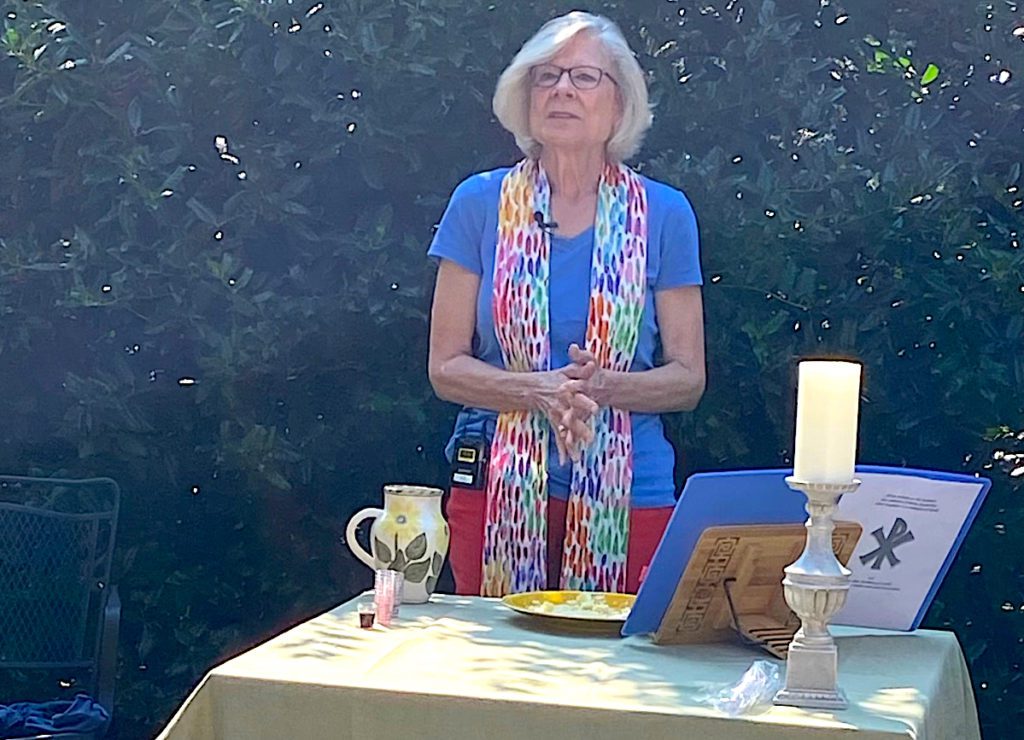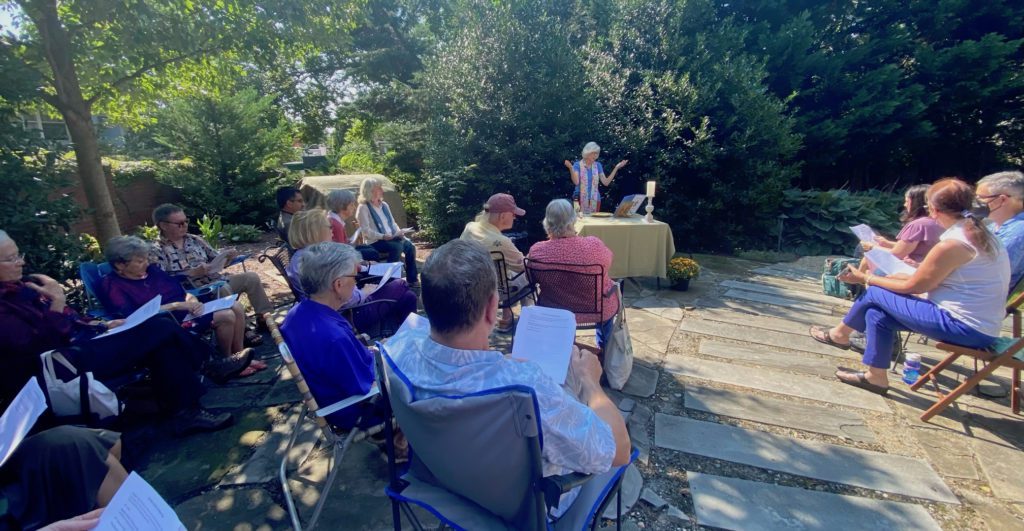Not on a Whim, Woman Catholic Priest Celebrates Momentous Georgetown Mass
By • September 22, 2022 15 7257

The Roman Catholic Church wears its age well — and yet, after 2,000 years, is still developing new features, still growing into its body. Perhaps, for world religions, 2,000 years seems like puberty: you’re at the age where lots of people know you and recognize you, but inside you’re expanding in ways that are still going to surprise them.
Georgetown is a place where some of the Catholic body’s most important parts can be found: two schools, two parishes and a world-famous university.
Now, this oldest neighborhood in Washington, D.C., is also home to a growing part of the Catholic Church that many Catholics would surely find a little surprising: women priests.
On Sunday morning, Sept. 18, in a secluded backyard garden on R Street, a community of Catholics gathered for what was likely the first ever Catholic Mass held in Georgetown celebrated by a woman.
Washington Home Inclusive Monthly Mass (WHIMM) organized the Mass and invited Rev. Kathleen Blank Riether to celebrate it. In person and remotely, roughly 30 Catholics prayed, read and worshiped, while sharing the sacrament of the Eucharist — the bread and wine — consecrated by the female Catholic priest.
“Sounds like heresy,” said an older member of Holy Trinity when I told him I was going. “My dad would probably say the same thing,” I replied with a smile. I went anyway.
I am not much of a rule breaker. I wasn’t even sure how comfortable I was going to WHIMM’s Mass in the first place. I am also a parishioner of Holy Trinity and attend daily Mass (not every day). I was born at Georgetown University Hospital and was raised in a conservative Catholic family. I was teased by my Italian grandmother for going to “pagan school” — I went to National Cathedral School. I graduated from Georgetown. And I am a disciplined former ballerina who likes to match her belt to her shoes and pay her credit card bill early.
It was at Holy Trinity where I first learned about WHIMM. A few months before the pandemic, WHIMM’s mission was shared with me at a lecture in the parish’s McKenna Hall about women in the early church. The lecture was co-hosted by the parish’s RCIA coordinator and a parishioner with a Ph.D. in theology from Catholic University, both women. When I learned how women were key evangelizers in the early church and were even ordained as deacons, these early Christian women reminded me of NCS’s former headmistress, Aggie Underwood, whose infamously intense academic environment taught us that — as women — we could do anything.
Catholics do not teach girls that they can do anything. If a girl raised in a Catholic church, who grows to love her church, is asked “What do you want to be when you grow up?” and she replies, “I want to become Pope,” the answer is, “No.” And yet, here I was, standing in a garden on R Street, witnessing a female Catholic priest bless me.

Rev. Kathleen Blank Riether celebrates a Catholic Mass in Georgetown on R Street. Courtesy Emilia Ferrara.
“We live in a finite, imperfect world in which every person and situation are an inextricable mix of both good and bad, right and wrong,” said Rev. Riether in her homily during Mass. “Though our minds want to automatically categorize people, situations, and things as right or wrong, good or bad, life is just not that simple… [Life] is a process of learning how to live with and negotiate the harsh realities of this world while upholding and living as fully as we can the teachings of Jesus.”
Reither belongs to Roman Catholic Womenpriest’s Eastern Region, an umbrella organization for the group of ten female Catholic priests called the Living Water Inclusive Catholic Community, the group from which WHIMM typically invites female priests. Based in Maryland, Living Water’s website states it began offering Masses in 2008 at the Unitarian Universalist Church in Annapolis and at the Stony Run Friends Meeting House in Baltimore. One of the leaders of Living Water is Andrea M. Johnson, a woman ordained deacon in 2005, priest in 2007, and now bishop as of 2009. Officially, the Catholic Church excommunicates women who are ordained priests. The ordained women claim the right of apostolic succession.)
Although WHIMM’s Masses are primarily celebrated in private homes, they also offer “Mass on Mass” for a larger gathering in an outdoor park on Massachusetts Avenue and Fulton Street NW. This open, public Mass is offered just steps from the Vatican Embassy, where participants walk to afterward for a short prayer service.
“The goal is not to just bemoan or dismantle what is broken,” says Jane Malhotra, WHIMM’s founder, “but to also build something better.” “Behold, I am making something new!” quotes the group on its website from Isaiah 43:19.
Malhotra was inspired by her aunt, Anne E. Patrick, and her book “On Being Unfinished,” where she explains a belief in creative responsibility: “a willingness to think deeply and originally… to take appropriate risks for the sake of promoting good…”. In that same spirit, Malhotra created WHIMM and through it a space for Catholics, who “want to renew the Church by experiencing a new model of ordained ministry.”
Malhotra’s creative responsibility is not unlike the prophetic obedience (another term coined by Malhotra’s aunt) followed by the women priests from Maryland’s Living Water Community: “Going towards the higher calling of conscience, towards the greater good, towards inclusive and divine justice and the dignity of all God’s creation, even if it means going against the rule of an institution.”
In December 2018, a group of Washington-area Catholics attended the first WHIMM Mass led by a woman priest at a home in Bethesda. In October 2019, the first public Mass was offered — “Mass on Mass” — in addition to ten home masses that year. By 2020, WHIMM Masses were celebrated in Arlington and Bethesda and continued remotely online during the pandemic.
At first, WHIMM started with about 15 Catholics. Then, Masses in private homes began collecting about 30 Catholics. Eventually, the Fulton Street public Mass gathered about 70 Catholics (“despite the rain”). Now, with an email list in the hundreds, a news crew filmed the Georgetown service, capturing attendees which WHIMM says exemplify a “growing community of Catholics seeking to live into the radical vision that Jesus calls us to, in unity with all God’s creation.”
So what is a WHIMM Mass like? Who was there? And what, if anything, was uniquely Georgetown about it?
At first, I felt like I was walking into a picnic (which perhaps, in its casual nature, isn’t too far from the Last Supper). A cardboard sign was taped to a tree to direct us where to walk to find the garden. A cheerful table was set up with mums for doughnut hour, complete with hot coffee and gluten-free pumpkin spice muffins from Trader Joe’s. The most notable culinary offering was actually the communion wine, a bottle of red with Snoop Dog’s face on it, which the label calls perfect for “rule breakers” and which the vintner calls “defiant by nature” and “bold in character.”
Everybody was lovely. The chairs were organized. The altar was recognizably set. The program was passed out. The readings, the psalm, the homily and the eucharist all played out like clockwork. But on this clock, there were some new features. There was no “Lord,” just “God” and “The Creator” (which sometimes took a feminine pronoun). The “Our Father” acknowledged both parents, beginning with “Our Father/Mother in heaven, hallowed be your name…”
Also, there was no unworthiness. Right about as we were to receive communion, instead of calling ourselves “unworthy,” we prayed a reminder that with Jesus we are worthy and that with his words we are healed. Though revised, the liturgy made perfect sense. It was as refreshing as it was heart-opening in a completely enlightened and still authentically Catholic way.

“At first, I felt like I was walking into a picnic…” Courtesy Emilia Ferrara.
I could tell you that it was very Georgetown because of the Cartier watches, pearl necklaces, Celtic cross pendants, pinky rings, diamond earrings, Nantucket reds and chats about summer travel. (To be sure, the expected Tevas were there, too). But that wasn’t what made it Georgetonian. I thought back to how a 53 year-old John Carroll started building his school before he even officially owned the land. And it made me remember that it was a can-do, self-starting, proactive and hardworking American spirit that built a new country and which also originally defined the community living in Georgetown.
Perhaps, when I was presented with a torn piece of a gluten-free English muffin (instead of a cross-stamped wafer), and heard “the body of Christ” and said “Amen,” I had a hard time believing it really was the body of Christ. Maybe I was confused that there was no man in a robe initiating transubstantiation. But, do I need a man to tell me I am a part of the body of Christ? No. Indeed, I had no doubt that — in the group gathered around me — we were all a new (if a little unfamiliar) part of the body of Christ. And to my right, the older Catholic woman pinched up every crumb left in her palm and ate every morsel so as to not let any part of Jesus fall to the ground.


Very nice work it is about time
Now let’s see: Mary did not disown her child before the cock crowed three times, Mary did not sell her son out for 30 pieces of silver; Mary did not wash her hands of any responsibility for the murder of Jesus. Mary was only the mother of Jesus who carried him to a manger in December and bore the pains of birthing her son among flock of sheep.
Can one seriously say that women could not be priests? Cannot they administer the sacraments of the church with the sincerity, intelligence and resolution of a man? This article goes to the heart of answering this question.
Georgetown was the birthplace of what is now the worlds capital city. Today its women should be welcome to serve as ministers of the Catholic faith and ordained to do so with full permit of the Pope.
Hooray for Emilia, hooray for Trinity and hooray for the Georgetowner for bringing to the attention of our town the need to flip an old totem upside down.
extremely interesting! Thank you Emilia for sharing this groundbreaking story!
The Jesuits have been at the forefront of change for the Catholic Church for centuries. Catholicism is ripe for change, particularly with respect to the role of women in its ranks. This will take some time to work out. But, the article serves as a reminder of a ripple in a waves that could very well turn into a tsunami.
As someone who was raised with a male reverend (I was raised Protestant instead of catholic) I am still a little shocked when I’m met with a female leading church. Women often have historically possessed a “lesser” position within the church, so I think it’s wonderful that WHIMM is giving faith-focused women the opportunity to preach and lead.
Who better than we decendents of Mary, has the right to say “this is my body, this is my blood”. Certainly not the men who have led wars and crusades and child abuse.
This is not a legitimate Catholic Mass. Please stop trying to change the Catholic church. Instead go ahead and create your own church. Why do you insist that the Catholic Church conform to what you believe instead why don’t you simply seek a church that conforms to your desires.
Umm. No. Not “a part of the Catholic Church”. Not Catholic. Heretical. These are imposters, posers who claim to be what they are not. At their heart they are disingenuous, fake, deceptive, and lacking in honesty. A perfect example of philosophical voluntarism: I do what I do because I want to do it and that’s all the truth I need. Relativism by any other name would still smell as noxious. A further complaint is the lack of journalist integrity. The Catholic Church has repeatedly rejected any claims by such heretical groups who claim to be a “part of the Catholic Church”. They are not. Those who participate in such fake rites are guilty of mortal sin and likely incurred excommunication latae sententiae. (automatic excommunication). They have made idols of themselves.
As someone who was raised Catholic, was a member of Holy Trinity in Georgetown and now lives in a conservative diocese in New Mexico, my husband and found it untenable to be part of the catholic church in our city. The conservative positions and actions of the church drove us away. We were often invited by Episcopalian friends to try out their parish. We did, and are very happy with our decision. We have had woman priests since the beginning, extremely knowledgeable and spiritual. Yes, it takes getting used to having a “mother” rather than a “father” saying Mass. Women have not had the lead role in services before. You get used to it. Our parish is filled with community, joy, service and love. Our involvement is welcomed and meaningful.
Women priests? Yes, but keeping the proper matter and form of the Eucharist is important. Snoop wine and English muffins…no.
Very interesting article the first time I read about women priest.
I have attended two Masses by Rev. Beverly and will attend another this fall. All are welcome in this place. <
Heretics
Book of Timothy clearly states that women should hold no teaching authority in the Church. It was done this way not to exclude women but to coincide with Jewish Tradition and also to separate our Cult from the cult of pagans who not just endorsed the priestess but considered priestesses essential form and function.
It’s clear you are preying on nonpracticing Catholics who don’t even know what their faith is or how it is actually governed. While there is possibility for women ministers in the future as Protestant denominations slowly come back into union with the Church, Rome itself has roundly rejected the possibility of women priests council after council, the last decision was rendered four or five years ago. If you are Catholic avoid this Church they are not in union with the Roman Catholic Church, they are not Roman Catholic and the writer of this article appears to believe that Catholic Churches are completely autonomous and without governance.
There is no spiritual, moral, or Biblical reason that women cannot be priests. Jesus had both male and female disciples. It was a woman who bore Him into the world. Even the men who wrote the Gospels acknowledged that all the male disciples either betrayed Him, denied Him, or ran away, while His female disciples stood with Him throughout His Passion and death, through His removal from the Cross and His burial.*It was to the women that Jesus first revealed His Resurrection, and when they proclaimed it to the men, the men refused to believe! The claim that Jesus only chose men is only supported if one takes the Bible literally, which Catholics do not do. To suggest that Jesus differentiated among His disciples based on physical characteristics such as genetalia is to state that women are inherently spiritually inferior to men, a position which the Catholic Church expressly rejects.
So to people like Connie and Mike, I say: Show me the heresy that I have spoken. There is none. Furthermore, like it or not, these women are priests in Apostolic succession. They cannot be excommunicated, not matter what words some human being utters or writes in a decree. And finally: No! We are not going away! We are baptized Catholics who hold fast to the belief that Jesus is fully present in the Eucharist. You cannot and will not take that away from us or force us out.
*The one exception being the Gospel of John, which recounts “the one whom Jesus loved” being at the foot of the Cross with Mother Mary. Of note, John was the last of the Gospels, having been written almost a century after Jesus walked the earth, and is not considered to be a factual account, but rather a theological one. The earlier Gospels, which did set out to be a more or less historical account of Jesus’ life, make no mention of this event.